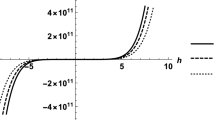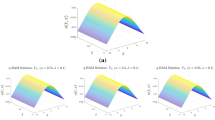Abstract
The principal objective of this study is to present a new numerical scheme based on a combination of q-homotopy analysis approach and Laplace transform approach to examine the Fitzhugh–Nagumo (F–N) equation of fractional order. The F–N equation describes the transmission of nerve impulses. In order to handle the nonlinear terms, the homotopy polynomials are employed. To validate the results derived by employing the used scheme, we study the F–N equation of arbitrary order by using the fractional reduced differential transform scheme. The error analysis of the proposed approach is also discussed. The outcomes are shown through the graphs and tables that elucidate that the used schemes are very fantastic and accurate.









Similar content being viewed by others
References
Fitzhugh, R.: Impulse and physiological states in models of nerve membrane. Biophys. J. 1, 445–466 (1961)
Nagumo, J.S., Arimoto, S., Yoshizawa, S.: An active pulse transmission line simulating nerve axon. Proc. IRE 50, 2061–2070 (1962)
Jone, D.S., Sleeman, B.D.: Differential Equations and Mathematical Biology. Chapman Hall/CRC, New York (2003)
Shih, M., Momoniat, E., Mahomed, F.M.: Approximate conditional symmetries and approximate solutions of the perturbed Fitzhugh–Nagumo equation. J. Math. Phys. 46, 023503 (2005)
Kawahara, T., Tanaka, M.: Interaction of travelling fronts: an exact solution of a nonlinear diffusion equation. Phys. Lett. A 97, 311–314 (1983)
Nucci, M.C., Clarkson, P.A.: The nonclassical method is more general than the direct method for symmetry reductions: an example of the Fitzhugh–Nagumo equation. Phys. Lett. A 164, 49–56 (1992)
Li, H., Guo, Y.: New exact solutions to the Fitzhugh–Nagumo equation. Appl. Math. Comput. 180, 524–528 (2006)
Abbasbandy, S.: Soliton solutions for the Fitzhugh–Nagumo equation with the homotopy analysis method. Appl. Math. Model. 32, 2706–2714 (2008)
Kakiuchi, N., Tchizawa, K.: On an explicit duck solution and delay in the Fitzhugh–Nagumo equation. J. Differ. Equ. 141, 327–339 (1997)
Schonbek, M.E.: Boundary value problems for the Fitzhugh–Nagumo equations. J. Differ. Equ. 30, 119–147 (1978)
Yanagida, E.: Stability of travelling front solutions of the Fitzhugh–Nagumo equations. Math. Comput. Model. 12, 289–301 (1989)
Jackson, D.E.: Error estimates for the semidiscrete Galerkin approximations of the Fitzhugh–Nagumo equations. Appl. Math. Comput. 50, 93–114 (1992)
Gao, W., Wang, J.: Existence of wavefronts and impulses to Fitzhugh–Nagumo equations. Nonlinear Anal. 57, 5–6 (2004)
Olmos, D., Shizgal, B.D.: Pseudospectral method of solution of the Fitzhugh–Nagumo equation. Math. Comput. Simul. 79, 2258–2278 (2009)
Dehghan, M., Heris, J.M., Saadatmandi, A.: Application of semi-analytic methods for the Fitzhugh–Nagumo equation, which models the transmission of nerve impulses. Math. Methods Appl. Sci. (2010). doi:10.1002/mma.1329
Miller, K.S., Ross, B.: An Introduction to the Fractional Calculus and Fractional Differential Equations. Willey, New York (1993)
Podlubny, I.: Fractional Differential Equations, vol. 198, p. 340. Academic Press, San Diego (1999)
Caputo, M.: Elasticita e Dissipazione. Zani-Chelli, Bologna (1969)
Kilbas, A.A., Srivastava, H.M.: Theory and Applications of Fractional Differential Equations, vol. 204, p. 540. Elsevier, Amsterdam (2006)
Baskonus, H.M., Mekkaoui, T., Hammouch, Z., Bulut, H.: Active control of a chaotic fractional order economic system. Entropy 17(8), 5771–5783 (2015)
Singh, J., Kumar, D., Nieto, J.J.: A reliable algorithm for local fractional Tricomi equation arising in fractal transonic flow. Entropy 18(6), 206 (2016)
Hristov, J.: Transient heat diffusion with a non-singular fading memory: from the Cattaneo constitutive equation with Jeffrey’s kernel to the Caputo–Fabrizio time-fractional derivative. Therm. Sci. 20(2), 765–770 (2016)
Kumar, D., Singh, J., Baleanu, D.: A hybrid computational approach for Klein–Gordon equations on Cantor sets. Nonlinear Dyn. 87, 511–517 (2017)
Kumar, D., Singh, J., Baleanu, D.: Modified Kawahara equation within a fractional derivative with non-singular kernel. Therm. Sci. (2017). doi:10.2298/TSCI160826008K
Yang, X.J., Machado, J.A.T., Baleanu, D.: On exact traveling-wave solutions for local fractional Korteweg–de Vries equation. Chaos 26, 084312 (2016)
Area, I., Batarfi, H., Losada, J., Nieto, J.J., Shammakh, W., Torres, A.: On a fractional order Ebola epidemic model. Adv. Differ. Equ. (2015). doi:10.1186/s13662-015-0613-5
Carvalho, A., Pinto, C.M.A.: A delay fractional order model for the co-infection of malaria and HIV/AIDS. Int. J. Dyn. Control 5, 168–186 (2017)
Machado, Z.A.T., Lopes, A.M.: Relative fractional dynamics of stock markets. Nonlinear Dyn. 86(3), 1613–1619 (2016)
Zhao, D., Singh, J., Kumar, D., Rathore, S., Yang, X.J.: An efficient computational technique for local fractional heat conduction equations in fractal media. J. Nonlinear Sci. Appl. 10, 1478–1486 (2017)
Ahmadian, A., Ismail, F., Salahshour, S., Baleanu, D., Ghaemi, F.: Uncertain viscoelastic models with fractional order: a new spectral tau method to study the numerical simulations of the solution. Commun. Nonlinear Sci. Numer. Simul. 53, 44–64 (2017)
Zaky, M.A., Machado, Z.A.T.: On the formulation and numerical simulation of distributed-order fractional optimal control problems. Commun. Nonlinear Sci. Numer. Simul. 52, 177–189 (2017)
Liao, S.J.: Beyond Perturbation: Introduction to Homotopy Analysis Method. Chapman and Hall/CRC Press, Boca Raton (2003)
Liao, S.J.: On the homotopy analysis method for nonlinear problems. Appl. Math. Comput. 147, 499–513 (2004)
Liao, S.J.: An approximate solution technique not depending on small parameters: a special example. Int. J. Non-linear Mech. 30(3), 371–380 (1995)
El-Tawil, M.A., Huseen, S.N.: The \(q\)-homotopy analysis method (\(q\)-HAM). Int. J. Appl. Math. Mech. 8, 51–75 (2012)
El-Tawil, M.A., Huseen, S.N.: On convergence of the \(q\)-homotopy analysis method. Int. J. Contemp. Math. Sci. 8, 481–497 (2013)
Khuri, S.A.: A Laplace decomposition algorithm applied to a class of nonlinear differential equations. J. Appl. Math. 1, 141–155 (2001)
Khan, M., Gondal, M.A., Hussain, I., Karimi Vanani, S.: A new comparative study between homotopy analysis transform method and homotopy perturbation transform method on semi-infinite domain. Math. Comput. Model. 55, 1143–1150 (2012)
Singh, J., Swroop, R., Kumar, D.: A computational approach for fractional convection–diffusion equation via integral transforms. Ain Shams Eng. J. (2016). Doi:10.1016/j.asej.2016.04.014
Kumar, D., Singh, J., Baleanu, D.: A fractional model of convective radial fins with temperature-dependent thermal conductivity. Rom. Rep. Phys. 69(1), 103 (2017)
Kumar, D., Agarwal, R.P., Singh, J.: A modified numerical scheme and convergence analysis for fractional model of Lienard’s equation. J. Comput. Appl. Math. (2017). Doi:10.1016/j.cam.2017.03.011
Singh, J., Swroop, R., Kumar, D.: Numerical solution of time- and space-fractional coupled Burgers equations via homotopy algorithm. Alex. Eng. J. 55(2), 1753–1763 (2016)
Srivastava, H.M., Kumar, D., Singh, J.: An efficient analytical technique for fractional model of vibration equation. Appl. Math. Model. 45, 192–204 (2017)
Odibat, Z., Bataineh, S.A.: An adaptation of homotopy analysis method for reliable treatment of strongly nonlinear problems: construction of homotopy polynomials. Math. Methods Appl. Sci. (2014). Doi:10.1002/mma.3136
Keskin, Y., Oturanc, G.: Reduced differential transform method: a new approach to fractional partial differential equations. Nonlinear Sci. Lett. A 1, 61–72 (2010)
Gupta, P.K.: Approximate analytical solutions of fractional Benney–Lin equation by reduced differential transform method and the homotopy perturbation method. Comput. Math. Appl. 58, 2829–2842 (2011)
Acknowledgements
The authors would like to thank the anonymous reviewers for their valuable comments and suggestions to improve the final version of the article.
Author information
Authors and Affiliations
Corresponding author
Rights and permissions
About this article
Cite this article
Kumar, D., Singh, J. & Baleanu, D. A new numerical algorithm for fractional Fitzhugh–Nagumo equation arising in transmission of nerve impulses. Nonlinear Dyn 91, 307–317 (2018). https://doi.org/10.1007/s11071-017-3870-x
Received:
Accepted:
Published:
Issue Date:
DOI: https://doi.org/10.1007/s11071-017-3870-x




